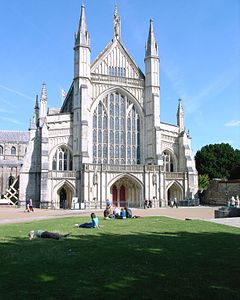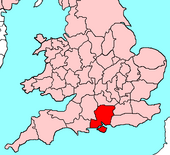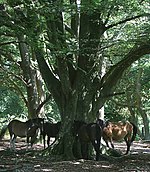Hampshire
| Hampshire United Kingdom | |
 Winchester Cathedral | |
|---|---|

| |
| Flag | |

| |
| [Interactive map] | |
| Area: | 1,622 square miles |
| Population: | 2,099,640 |
| County town: | Winchester |
| Biggest town: | Southampton |
| County flower: | Dog-rose [1] |
The County of Southampton (shortened to Hampshire) is a shire on the south coast of Great Britain. The main body of the county is separated from the Isle of Wight by the Solent and Spithead. The county town is Winchester, capital of Wessex and of England until about 1100.
Its place on the English Channel and the presence of several excellent natural harbours has given Hampshire a pre-eminent place in British sea-going endeavours from early times to the present.
Hampshire has first place in the defence of the realm; Portsmouth is the home of the Royal Navy, Aldershot is the Army's biggest fixed camp and Farnborough has long been at the heart of the industries developing military aircraft.
The origin of Hampshire's name is the City of Southampton, know in Anglo-Saxon days as Hamwic or Hamtun, hence Hamtunscir. Hampshire has historically been referred to as Southamptonshire[1] and the County of Southampton.[2]
Hampshire is a diverse county. The busy ports of Southampton and towns around the Solent process more overseas trade than any other place in Britain and have created a major urban area. Outside the cities though, rural Hampshire takes over, a land of farms and small villages.
The county is a popular holiday destination, with tourist attractions and seaside resorts such as Bournemouth, and national parks in both the New Forest in south-western Hampshire and the South Downs, which intrude in the east.
Hampshire has a long maritime history. Portsmouth, home of the Navy, and Southampton are two of England's largest ports, while the yachting fraternity gathers in towns all along the coast such as Fareham, near Portsmouth, and Cowes on the Isle of Wight, the latter hosting "Cowes Week" each year.
Hampshire's county flower is the dog rose.[3]
Contents
Geography
Hampshire's south coast is characterised by clay soils and gravel but protected from the erosion typical along the exposed parts of the south coast by the Isle of Wight and, in the west, by Isle of Purbeck, part of Dorset, the sea has eaten into the land in the east to created the large convoluted lands of Portsmouth Harbour and its neighbours. These low, flat lands support heathland and woodland habitats, a large area of which form part of the New Forest. The Isle of Wight is though to have been separated from the mainland where softer rock has eroded away to form the Solent.
In the north and centre of the county the substrate is the Southern England Chalk Formation seen in Salisbury Plain and the South Downs and in Hampshire by hills with steep slopes where they border the clays to the south. A large area of the downs is now protected from further agricultural damage by the East Hampshire Area of Outstanding Natural Beauty. The Itchen and Test are trout rivers that flow from the chalk through wooded valleys into Southampton Water. Nestled in a valley on the downs is Selborne, and the countryside surrounding the village was the location of Gilbert White's pioneering observations on natural history recorded in "The Natural History of Selborne".
Southampton Water is a gash deep into the land, producing deep natural harbour almost ten miles long.
The highest point in the county is Pilot Hill, which reaches 938 feet, while its highest village is Bentworth, near Alton.
The New Forest
The New Forest takes up the graeter part of south-western Hampshire between Southampton Water and Christchurch and Bournemouth. It is some 220 square miles of heath, mixed woodland and grass with a great variety of wildlife.
The forest has been a protected environment since the days of William the Conqueror when it was declared a royal forest, but after the removal of the brutal mediaeval forest laws, the New Forest remained common land managed by the Court of Verderers. The New Forest became a National Park in 2005, to protect the landscape and wildlife, though it has added nothing practical to the protection the Forest already enjoyed.
Large areas of the New Forest are open common lands kept as grassland by grazing animals, including domesticated ponies, cattle and pigs. Several wild deer species roam here too.
The Isle of Wight
The Isle of Wight covers an area of 148 square miles. Slightly more than half of the island, mainly in the west, is designated as the Isle of Wight Area of Outstanding Natural Beauty. The island is mainly farmland, with a number of small towns. Its coastline is 57 miles of coastline. The landscape of the island is remarkably diverse, leading to its oft-quoted description of "England in Miniature".
The island's highest point is St Boniface Down, at 791 feet.
West Wight is predominantly rural, with dramatic coastlines dominated by the famous chalk downland ridge, running across the whole island and ending in The Needles stacks — perhaps the most photographed aspect of the Isle of Wight.
The River Medina flows north into the Solent, whilst the other main river, the River Yar flows roughly north-east, emerging at Bembridge Harbour at the eastern end of the island. There is another entirely separate river at the western end also called the River Yar flowing the short distance from Freshwater Bay to a relatively large estuary at Yarmouth. To distinguish them, they may be referred to as the Eastern and Western Yar.
Wight is known as one of the most important areas in Europe for dinosaur fossils. The eroding cliffs often reveal previously hidden remains.
Cities, towns, and villages
Hampshire's county town is Winchester, a historic city that was once the capital of the ancient kingdom of Wessex and of England until the Norman conquest of England. The greatest towns though are the port cities of Southampton and Portsmouth, which with Fareham, Gosport and Havant have effectively grown together into a conurbation that stretches along the coast.
The three cities of Hampshire each now hosts a university: the University of Southampton and Southampton Solent University (formerly Southampton Institute); the University of Portsmouth; and the University of Winchester (formerly known as University College Winchester; King Alfred's College).
Hampshire lies outside the green belt area of restricted development around London, but has good railway and motorway links to the capital, and in common with the rest of the south-east has seen the growth of dormitory towns since the 1960s. Basingstoke, in the north of the county, has grown from a country town into a business and finance centre.
Cities:
Other larger towns:
- Aldershot
- Andover
- Basingstoke
- Bournemouth
- Carisbrooke
- Christchurch
- Cowes
- Eastleigh
- Farnborough
- Fareham
- Gosport
- Havant
- Newport
- Ryde
- Waterlooville
Notes
- ↑ Cox, Thomas (1738). Magna Britannia, Antiqua et Nova, A Survey of England, wherein to Camden's Topographical Account is added a more large History of Cities, Towns, Boroughs, Parishes and Places. http://www.envf.port.ac.uk/hantsgaz/hantsgaz/hgandx_f.htm.
- ↑ Encyclopædia Britannica, 1911 edition "Hampshire"
- ↑ BBC News, May 5, 2004. UK counties choose floral emblems.
See also
References
- Encyclopædia Britannica Eleventh Edition. "Hampshire"
- Draper, Jo. 1990. Hampshire. Wimborne: Dovecote Press. ISBN 0-946159-82-3
- Pigot & Co's Atlas of the Counties of England, 1840. London: J Pigot & Co.
Outside links
- Walks Around Hampshire
- BBC Hampshire
- Hampshire Visitor Attractions
- 93 Vintage Photographs of Portsmouth from the Air
- Historic Farnborough
- Hampshire Local Community Website
- Winchester City Council
- Days out in Hampshire
| Counties of the United Kingdom |
|---|
|
Aberdeen • Anglesey • Angus • Antrim • Argyll • Armagh • Ayr • Banff • Bedford • Berks • Berwick • Brecknock • Buckingham • Bute • Caernarfon • Caithness • Cambridge • Cardigan • Carmarthen • Chester • Clackmannan • Cornwall • Cromarty • Cumberland • Denbigh • Derby • Devon • Dorset • Down • Dumfries • Dunbarton • Durham • East Lothian • Essex • Fermanagh • Fife • Flint • Glamorgan • Gloucester • Hants • Hereford • Hertford • Huntingdon • Inverness • Kent • Kincardine • Kinross • Kirkcudbright • Lanark • Lancaster • Leicester • Lincoln • Londonderry • Merioneth • Middlesex • Midlothian • Monmouth • Montgomery • Moray • Nairn • Norfolk • Northampton • Northumberland • Nottingham • Orkney • Oxford • Peebles • Pembroke • Perth • Radnor • Renfrew • Ross • Roxburgh • Rutland • Selkirk • Shetland • Salop • Somerset • Stafford • Stirling • Suffolk • Surrey • Sussex • Sutherland • Tyrone • Warwick • West Lothian • Westmorland • Wigtown • Wilts • Worcester • York |



